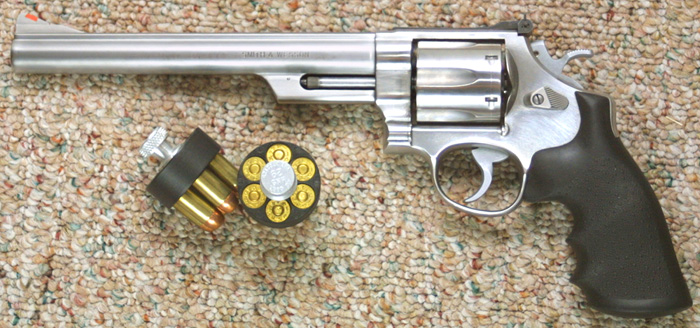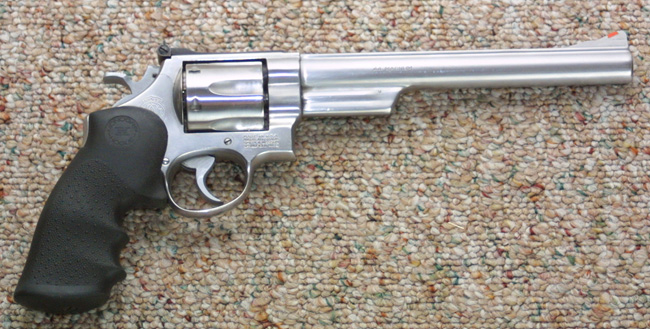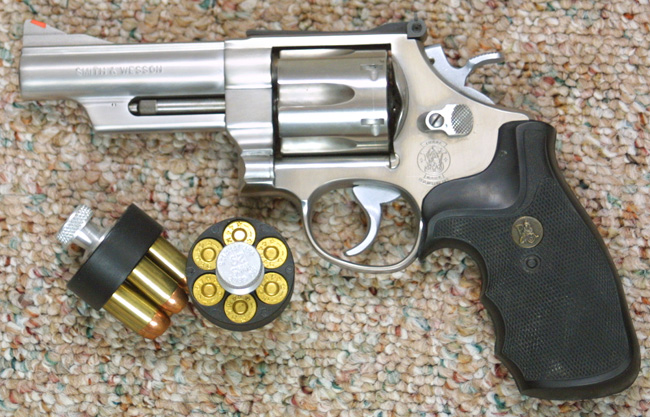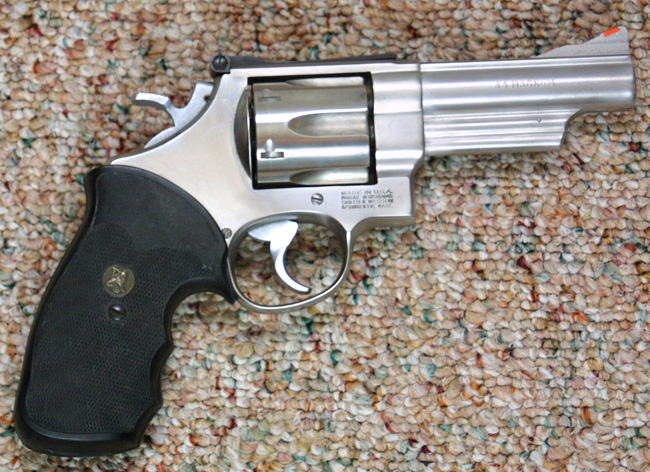
|
|
||||
| Dimensions | Barrel Length | Weight | Caliber | Action Type | Magazine capacity |
| 9 5/8 Inches | 4 Inches | 41.5oz. | .44 Magnum | D.A. Revolver | 6 |
| 13 7/8 inches | 8 3/8 inches | 49.5oz | .44 magnum | D.A. Revolver | 6 |
 gun, in being rendered in Stainless steel, rather than high carbon steel.
This is an improvement of sorts, but has it's drawbacks as well. The major
advantage of stainless steel, is it's resistance to corrosion. It should
be noted that this is a resistance only. No metal is completely immune to
corrosion, though stainless comes pretty close. Like the parent gun, the
stainless models were offered in stock barrel lengths of 4" 6" and 8 3/8",
though barrels as short as 3", and as long as 12" have been made available.
gun, in being rendered in Stainless steel, rather than high carbon steel.
This is an improvement of sorts, but has it's drawbacks as well. The major
advantage of stainless steel, is it's resistance to corrosion. It should
be noted that this is a resistance only. No metal is completely immune to
corrosion, though stainless comes pretty close. Like the parent gun, the
stainless models were offered in stock barrel lengths of 4" 6" and 8 3/8",
though barrels as short as 3", and as long as 12" have been made available.
Early stainless steel guns garnered a rather bad reputation. This was in part due to the hardness of stainless steel, and also to the grain structure which can make the guns subject to galling. Stainless wore out tools faster, and was harder to machine, making the guns a bit looser toleranced. Stainless barrels were said to be a bit less accurate, while the frames were said to be too stiff to shake off the cumulative effects of recoil. There was a measure of truth to all of these misgivings, for the early guns, but much of the trouble came from the novelty of the material, and the unfamiliarity that most gun makers had with it, rather than any deficiency in the metal. The early guns tended to be small J-frame models, though eventually medium sized guns were built on the K-frame. These little guns emphasized corrosion resistance, and disregard of neglect. Features that were thought to be more important, for the role of a small concealment piece, than accuracy, and long term durability. It was considered to be a worthwhile trade off.
Times have changed somewhat. Different formulations have been devised for stainless steel, and gun makers have become more experienced in working with it. Most of the early problems associated with stainless firearms have been solved, while work arounds have been found for the rest. The only real difference that I notice, between the carbon steel, and stainless steel guns is a certain "grittiness" in the double action trigger of the stainless guns. This is completely subjective, and may be my imagination. Even if true, it may be that these guns, being a bit newer, have not been broken in to the extent that my model 29 has. The single action pull of the stainless guns is the equal of the carbon steel versions. In consideration of the fact that I already own a 6" model 29, my stainless guns have the longest (8 3/8"), and the shortest (4") barrels commonly available on an N frame Smith.
The longer barreled gun is quite accurate, as should be expected. I can shoot into two inches with this gun, at the pistol range. Though not exactly handy and easy to carry, this gun is not too cumbersome, in a shoulder holster. The gun has full sized rubber grips, with finger cut outs. This helps quite a bit, as the stock grips on these guns can be a bit lacking in ergonomics. The gun has a shoulder holster, along with a set of speed loaders, and a pouch for them. Recoil seems to be moderated a bit, because of the longer barrel. There is certainly less muzzle flash, than out of a shorter barreled gun. All in all, this is a very easy gun to shoot, and quite pleasant with all but the heaviest loads, despite the reputation of the "mighty" .44. This is a somewhat newer model, as can be seen from the newer style cylinder latch. The frame, just inside of the crane, is marked 629-4.
 The shorter gun shoots into about three inches, perhaps
a bit better. It, too, has rubber grips, though these are the shortened
version. This revolver can be a real handful, with the short barrel. Muzzle
flash is excessive, unless the proper hand loads are used. This would seem
to be a better choice for .44 special loads, or for lightly loaded .44 magnums.
This is a chunky little beast, and fits nicely into a regular belt holster
and rig. The 4" gun is a superb field piece, and this would be my kit gun
of choice, for open carry in the outdoors. The gun is sturdy, substantial,
accurate enough, and handy enough. In all honesty, I can shoot this gun about
as well as the longer barreled version. As with all stainless guns, exposure
to the elements is not a big concern. As with all "N" frame Smiths, rough
treatment is not a big concern either; you can just about pound nails with
these big revolvers. This is an older 629. It has the old style cylinder
latch, but not the countersunk chambers. The frame is marked 629-2.
The shorter gun shoots into about three inches, perhaps
a bit better. It, too, has rubber grips, though these are the shortened
version. This revolver can be a real handful, with the short barrel. Muzzle
flash is excessive, unless the proper hand loads are used. This would seem
to be a better choice for .44 special loads, or for lightly loaded .44 magnums.
This is a chunky little beast, and fits nicely into a regular belt holster
and rig. The 4" gun is a superb field piece, and this would be my kit gun
of choice, for open carry in the outdoors. The gun is sturdy, substantial,
accurate enough, and handy enough. In all honesty, I can shoot this gun about
as well as the longer barreled version. As with all stainless guns, exposure
to the elements is not a big concern. As with all "N" frame Smiths, rough
treatment is not a big concern either; you can just about pound nails with
these big revolvers. This is an older 629. It has the old style cylinder
latch, but not the countersunk chambers. The frame is marked 629-2. The four inch version is a great field gun, and the 44 Magnum has developed into a very versatile cartridge, particularly for the hand loader. In addition to the stainless construction, the gun has rubber grips, rather than the traditional wooden style. There is thus nothing to corrode, warp, or rot. These guns will probably be around, and functioning, in a hundred, if not several hundred, years. The only traditional material on the gun is the blue metal of which the sights are made. This is just as well, since stainless or nickel rear sights are
 notoriously hard to use.
notoriously hard to use. The stainless 629 is still being produced. The latest version of the short barreled 44 is called the Mountain Gun. The N frame has been around for over 100 years, and the 44 Magnum since 1955. The stainless Model 629 was introduced in 1978, to be joined by stainless versions of the Model 57, and Model 27. Eventually, all of these guns went out of production, in traditional blue steel, and were available only in stainless.